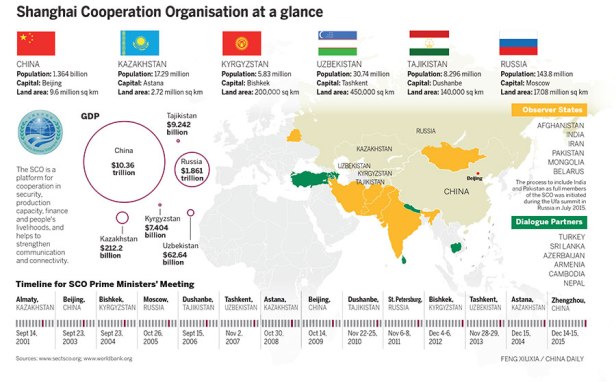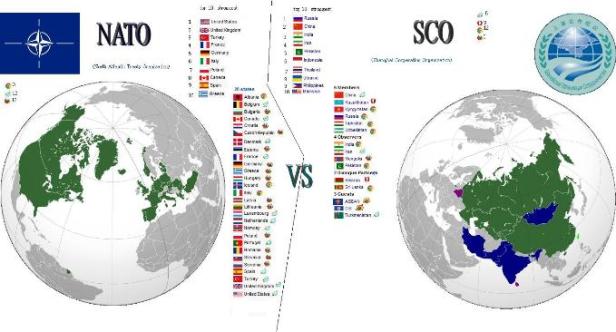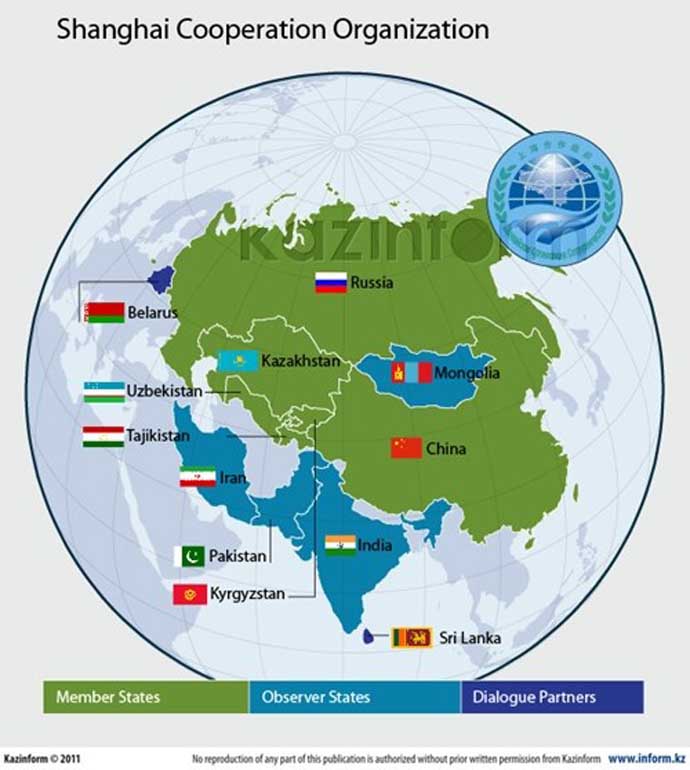Timeline of Shanghai Cooperation Organization (SCO) and related events
Important preceding Events
August 31, 1907: Anglo-Russian Entente: United Kingdom, Russian Empire, French Republic. Triple Alliance: Germany, Austria-Hungary, Kingdom of Italy.
1914: WWI; Allies: British Empire, Russian Empire, French Republic, Empire of Japan,
1915-16: WWI; Allies: Britain (UK), Russia, French, Japan, Italy, Portugal, Romania
1917-1918: WWI; Allies: UK, Russia… etc, United States, Central American States, Brazil, Greece, Siam, Republic of China, Liberia
1914-1915: WWI; Central Powers (Quadruple Alliance): Germany, Austria-Hungary, the Ottoman Empire (Turks), Bulgaria.
January 18, 1919: Paris Peace Conference (Versailles) drafted proposal of the League of Nations.
January 10, 1920: League of Nations was founded with 42 original members; in 1934 increased to 58 countries, and by 1946 only 24 remained.
August 10, 1920: Treaty of Sevres; began partition of the Ottoman Empire (Turkey, etc.) Principal Allied Powers: UK, France, Italy, Japan, Serbia
1939-1945: WWII; Allies: Great Britain (UK), United States, China, Soviet Union; also: France, Poland, Canada, Australia, Greece, Philippines, Norway and a dozen others including Cuba; and included the British Commonwealth.
Note: Japan and Italy leave Allies WWI Alliance:
1939-1945: WWII; Axis Powers: Nazi Germany, Empire of Japan, Kingdom of Italy; Bulgaria; and Hungary, Romania, Thailand, Iraq; and others control by the main Powers.
January 1, 1942, representatives of 26 nations pledged that their nations will continue to fight together against the Axis Powers. The name ‘United Nations’ was then coined by President F. D. Roosevelt.
October 24, 1945: The United Nations (UN) officially is established.
January 10, 1946: First General Assembly of the UN with 51 Member States met in London.
May 14, 1948: (year 5708 Hebrew Calendar): Israel declared a state. Note: UN overseeing Palestine Solution, as well as partition of Germany. Islamic Nations called for control of Palestine.
April 4, 1949: North Atlantic Treaty Organization (NATO) formed with 12 countries: primarily: UK, US, France, Canada, Demark, Italy (switches to allies); in 1952 Greece and Turkey joined; in 1955 Germany; in 1982 Spain; in 1999 Czechs, Hungary, Poland; in 2004 seven nations joined including Romania; in 2009 Albania and Croatia joined making 28 members currently (February 2017).
May 14, 1955: the Warsaw Pact was established (Treaty of Friendship, Co-operation, and Mutual Assistance): Soviet Union, Bulgaria, Czechoslovakia, [East Germany, Hungary and Poland (all withdrew in 1990)], Romania and Albania (until 1968).
August 8, 1967: the Association of Southeast Asian Nations (ASEAN) was established in Thailand, with also Indonesia, Malaysia, Philippines and Singapore as chief members.
| Kyrgyzstan: By 1685, the Oirats of Mongolia conquered Turkish tribes. Then in 1758, the Oirats were defeated by the Chinese empire. By 1876 the Russians conquered the land and it came into the Russian empire. During WWI the Russians suppressed a rebellion, but for years Civil wars continued until about 1923. At that time it was part of Turkestan under the Soviet Socialist Republic, which in 1936 became known as the USSR. In 1991, after conflicts between the Uzbeks and Kyrgyz, Kyrgyzstan gained its independence from the USSR; and it joined the UN in 1992. In 2002, the government agreed to give land to China; in 2003 Russia built an air force based in Kant near the US leased base. |
December 1991: the USSR dissolves and most of the former Soviet territories or states agreed to the Collective Security Treaty Organization.
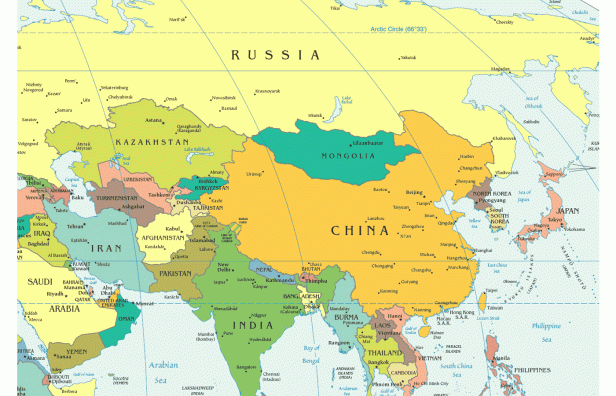
Timeline of Shanghai Cooperation Organization (SCO)
May 15, 1992: Collective Security Treaty Organization (military alliance) was signed: Russia, Kazakhstan, Kyrgyzstan, Tajikistan (all part of Shanghai 5); also joining in 1994: Armenia, Belarus, Uzbekistan, Azerbaijan, Georgia; and in 2013 Afghanistan and Serbia.
April 26, 1996: First Summit Meeting of ‘Shanghai Five:’ Heads of state of China and Russia and three former Soviet states met in Shanghai to discuss regional security and resolve border conflicts.
April 24, 1997: Second Summit Meeting of the S-5 was held in Moscow. They agreed to continue to reduce military forces in their border areas.
July 3, 1998: Third Summit in Kazakhstan: Focused on peace, stability and economic cooperation.
June 14, 2001: Sixth Summit Meeting of ‘Shanghai Five:’ Presidents of the ‘Shanghai Five’ member states – China, Russia, Kazakhstan, Kyrgyzstan and Tajikistan –announced Uzbekistan’s membership. The organization still exists: http://odkb-csto.org/
June 15, 2001: Sixth Summit: Leaders held the first Shanghai Cooperation Organization (SCO) Summit in St. Petersburg Russia where they signed the Charter of the SCO.
October 10-11, 2002: location China-Kyrgyzstan: Chinese People’s Liberation Army (PLA) and armed forces of Kyrgyzstan held joint anti-terror military exercises code-named ‘Exercise-01’ on the border of the two countries. It was the first bilateral military exercise conducted by SCO members.
May 29, 2003: Third SCO Summit: Chinese Ambassador to Russia Zhang Deguang became the first Secretary-General of the SCO.
August 6-12, 2003: Five SCO member countries (China, Kazakhstan, Kyrgyzstan, Russia and Tajikistan) took part in a joint anti-terror exercise code-named ‘Coalition-2003’
June 17, 2004: Fourth SCO Summit: Granted Mongolia observer status.
February 25, 2005: Iran submitted application for SCO full membership.
June 2005: The United States was denied observer status in the SCO.
July 5, 2005: Fifth SCO Summit: Granted India, Iran and Pakistan observer status.
July 13, 2005: Fifth Summit: Heads of SCO issue international statement: “The heads of the member states point out that, against the backdrop of a contradictory process of globalization, multilateral cooperation, which is based on the principles of equal right and mutual respect, non-intervention in internal affairs of sovereign states, non-confrontational way of thinking and consecutive movement towards democratization of international relations, contributes to overall peace and security, and call upon the international community, irrespective of its differences in ideology and social structure, to form a new concept of security based on mutual trust, mutual benefit, equality and interaction.”
August 18-25, 2005: China-Russia held their first joint anti-terror military exercises code-named “Peace Mission-2005.” The one-week maneuver involved 10,000 troops from the two countries. Also called Sino-Russian wargames.
According to a China Center for Contemporary World Studies (CCCWS) 2013 article: “Prior to 2005, the U.S. Congressional Research Service (CRS) mentioned little about the SCO in their annual reports on the Central Asian situation. Academics seldom systematically talked about the SCO… After the SCO’s Astana Summit in 2005, the United States adjusted its policy towards the organization accordingly. The U.S. domestic mainstream view was that the United States should establish a positive dialogue with the SCO so as to prevent it from becoming Russia’s and China’s tool for dominating Central Asia.”
December 14, 2005: Idea for ASEAN+3 (China, Japan, S. Korea) began in 2002, though the concept was suggested in 1991 by the PM of Malaysia. This First East-Asia Summit began with 16 members: ASEAN (10)+Plus Three and India, Australia and New Zealand. Russia (attended as a guest); (Russia and the United States joined in 2011 – 6th EAS)
February 21-22, 2006: First meeting of the SCO Interbank Association.
September 22-23, 2006: Sixth SCO Summit: China and Tajikistan held their first joint anti-terror military exercise code-named ‘Coordination-2006’
August 9-17, 2007: SCO joint military exercises (Sino-Russian Wargames) code-named ‘Peace Mission-2007’ included 6 SCO member countries and took place in the Ural mountain region of Russia and China. It was the SCO’s largest to date.
January 7, 2008: a CRS Report for Congress on ‘Emerging Trends in the Security Architecture in Asia’ states, “China’s rise represents the key driver in the changing security landscape in Asia. China is now attracting regional states with its economic power… Some also interpret China’s more active involvement in the Shanghai Cooperation Organization (SCO), which conducted substantial military exercises in 2007, as China’s attempt to develop an alternative security group to America’s security partnerships in the region. China’s announced defense spending rose by 17.8% to approximately $45 billion 2007, following a 14.7 increase in 2006. Some analysts estimate real Chinese defense expenditure to be up to three times this amount… In essence, China’s increasing economic, diplomatic, and military strength is compelling countries to rethink existing security arrangements and take initial steps that may lead to the formation of regional groupings of nations with common interests and values.’
August 8, 2008: Eighth SCO Summit
June 15-16, 2009: Ninth SCO Summit: This was the first time that leaders from the observer states of Mongolia, India and Pakistan were included.
June 10-11, 2010: Tenth SCO Summit: In addition to the 6 members and 3 previous observer members; the Min. of Foreign Affairs of the Islamic Republic of Iran and the President of the Islamic Republic of Afghanistan were present as guests. SCO Press Release stated, “The member states supported strengthened cooperation with the SCO observer states and dialogue partners… and welcomed …granting the SCO dialogue partner status to the Republic of Belarus and the Democratic Socialist Republic of Sri Lanka.”
More on SCO military exercises 2002-2010:
http://www.clingendael.nl/sites/default/files/20070900_cscp_paper_haas.pdf
June 14-15, 2011: 11th SCO Summit: SCO is now 10 years old. Summit discussed ‘combating drug trafficking, the situation in Afghanistan, and economic and humanitarian cooperation between the SCO member states.’ Along with the presidents of Russia, China, Kazakhstan, Kyrgyzstan, Tajikistan, Uzbekistan, delegations from India, Iran, Mongolia, and Pakistan, which have observer status in the SCO, took part in the summit. Presidents of Afghanistan and Turkmenistan and representatives of the UN, CIS, EurAsEC, CSTO and ASEAN attended as guests. The SCO called for stability in North Africa and the Middle East.
November 12, 2011: Iranian Supreme National Security Council declared that it was again seeking full membership in the SCO, telling reporters in Moscow, ‘We have already submitted a relevant application.’ Iran denied ‘full membership’ while on the United Nation’s Sanctions List (Jan. 2016 sanctions lifted on Iran; about a year later they broke agreements by testing nuclear missiles.)
April 23, 2012: Chinese and Russian joint ‘Naval War Games,’ called ‘Naval Cooperation-2012’ began as part of ‘a deepening strategic partnership’ between the two super-powers. The operations in the Yellow Sea involved air defenses, anti-submarine and submarine warfare, as well as electronic countermeasures and unspecified ‘sensitive technologies.’
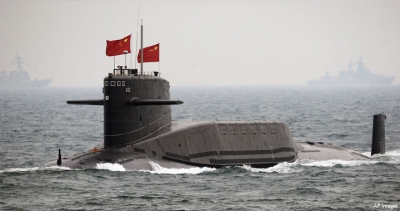
| April 24, 2012: The New American reports, “During the Cold War, the two communist dictatorships were often painted as rivals at odds with each other over supposed matters of ‘ideology’ and more. In reality, however, analysts and defectors from both regimes have documented that the bogus ‘rivalry’ was mostly a disinformation and propaganda scheme aimed at gullible Western populations.
In recent years, the two governments have held multiple military exercises under the banner of the Shanghai Cooperation Organization (SCO) …This week’s war games, however, mark the first time in recent memory that both navies joined forces for such a large-scale joint training effort. So-called ‘integration’ in military and intelligence matters between the governments is expected to continue deepening. According to Chen Bingde, chief of the general staff of the People’s Liberation Army, the alliance demonstrates the regime’s supposed commitment to maintaining world ‘peace’ and stability’.” |
June 6-7, 2012: 12th SCO Summit: Chinese President Hu Jintao presided over the Meeting of the Council of Heads of Member States of the SCO at the Great Hall of the People in Beijing. According to the SCO 2012 Summit Press Release, “The President made a four-point proposal for the future development of the organization. He called on the member states to make joint efforts to build the SCO into a harmonious community, a fortress of regional security and stability and a driving force to boost regional economic development… Russian President Vladimir Putin said the SCO should enhance security cooperation, deepen economic cooperation, encourage people-to-people exchanges and open itself up to outside parties and international organizations.”
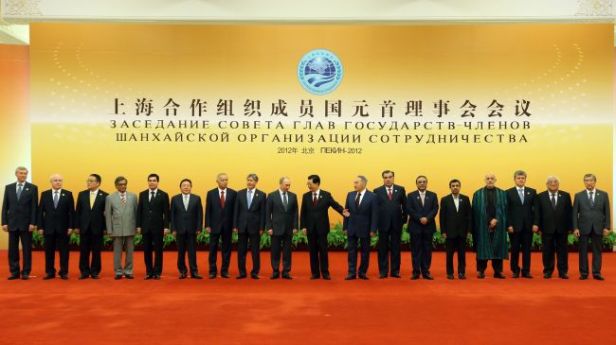
October 2012: N.Y. Post interview with former Sec. of State, Bilderberg and Trilateral Commission member, Nobel Prize winner, Henry Kissinger. He said, ‘in 10 years, there will be no more Israel.’ In Feb. 2013, in an interview with the Daily Squib, Kissinger stated, “The United States is baiting China and Russia, and the final nail in the coffin will be Iran, which is, of course, the main target of Israel. We have allowed China to increase their military strength and Russia to recover form Sovietization… If you can’t hear the drums of war you must be deaf…”
September 13, 2013: 13th SCO Summit: Discussed ‘new Silk Route will lead from Asia to Europe;’ Drug traffic and trans-border crime; and Syria situation. Voice of Russia (Sputnik News) 9/14/13: ‘Summit show SCO can oppose to any interference in other countries’ affairs.’
| August 2014: Strategic Studies Institute and U.S. Army War College Press issues a white paper called ‘Strategic Implications of the Evolving Shanghai Cooperation Organization.’ They state: “The significance of the organization for U.S. interests is widely misunderstood. The organization is emphatically not a military bloc, and yet engages in joint activities which resemble military cooperation to U.S. eyes… Its rhetoric firmly opposes U.S. presence and activity on the territory of member states (45% of world’s population), and yet individual member states leverage basing agreements with the United States to their advantage… Specific policy aims of the SCO… should not be analyzed according to U.S. policy criteria… The SCO is an enduring association was originally brought together by the short-term border security interests of its first five members. Russia believes it plays a leading role… however the organization is and always has been driven by China, and Moscow’s role is vital but secondary… The SCO is unlikely to enlarge further… SCO’s most important… component …is its Regional Anti-Terrorist Structure (RATS). Following the U.S. and NATO drawdown in Afghanistan in 2014, the RATS will certainly be reinforced, but there is no indication to date that the organization as a whole will move any closer to becoming a military alliance… While the SCO as an organization does not mount any direct challenge to U.S. interests, its political role as a coalition of anti-U.S. sentiment is likely to develop further in the future.”
http://www.strategicstudiesinstitute.army.mil/pdffiles/PUB1217.pdf |
| They called the SCO ‘an accidental alliance.’ Consider even the name: Shanghai (Shanghai Summit Meetings – 1996); Cooperation (Treaty of Friendship, Co-operation, and Mutual Assistance – 1955); and Organization (Collective Security Treaty Organization – 1992 and still in existence). I do not see the organization or its potential future benefits as an accidental organization. But, I guess those who saw the Trilateral Commission as an accidental ongoing entity would say the same thing. I do not understand how professional military analysts can make such conservative statements and estimates that are so important to our future. Maybe adding some small countries is no big deal to these analysts, but I assure you that the SCO is most certainly ‘moving closer to becoming a military alliance’ if it is not already one. (2017). See below – that looks like ‘military’ and an ‘alliance.’ |
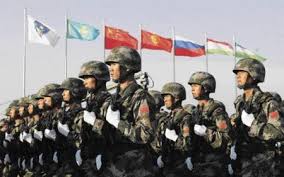
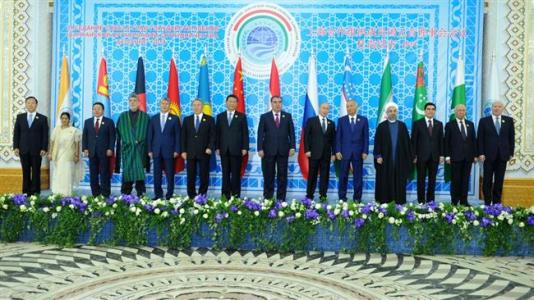
September 11-12, 2014: 14th SCO Summit (picture above): SCO finalized procedures for India, Iran and Pakistan to become full members. The SCO reported, “The unilateral and unlimited strengthening of MISSILE DEFENSE SYSTEMS by any individual state or any group of states will undermine international security and strategic stability.” But the statement was also a protest to U. S. allies building new missile defense systems.
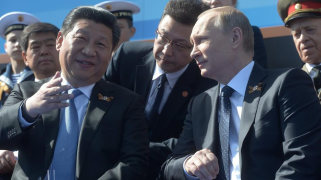
May 9, 2015: (above) 70th Anniversary of Victory Day was celebrated by Presidents Putin and Jinping.
May 2015: Through Russia and China have no border on the Mediterranean they are conducting First Joint NAVAL WAR GAMES. “People who call this an axis of convenience … are missing the bigger picture. This is a relationship about national identity and the big efforts in both countries to establish a different kind of international order.” said Gilbert Rozman, Princeton University professor on Northeast Asian affairs.
| May 11, 2015: L.A. Times reporting from Moscow: “Among the deals signed during Xi’s visit are a Chinese-financed and Russian-guaranteed investment fund aimed at drawing $25 billion in Chinese projects to Russia, a nearly $6-billion investment by Beijing in a high-speed rail line from Moscow to Kazan, $2 billion for agricultural projects and a $3-billion joint venture to build 100 long-haul Sukhoi jumbo jets for lease to carriers throughout Asia… Talks are still underway on China’s plan to purchase two dozen Su-35 fighter jets and to jointly upgrade the Mi-26 helicopter. In addition to diversifying Russia’s energy-intensive trade, the deals are forecast to double Russia-China annual trade to $200 billion within a few years. China’s trade volume with the United States, its most significant economic relationship, was $592 billion last year.” |
May 2015: Philippine Ambassador to Russia Carlos Sorreta said, ‘this is potentially a problematic mix… we all need to work very hard to come to a strategic cooperation.’ The Philippines’s envoy to Russia said they saw potential in cooperation between ASEAN (Association of Southeast Asian Nations), EEU (Eurasian Economic Union) and SCO.
| June 8, 2015: TheDiplomat.com writes, SCO-BRICS: A Big Summit in Ufa: “Since the beginning of the Ukraine crisis there has been a clear shift in the tectonic plates of global geopolitics. An increasingly assertive Russia and China are challenging the U.S.-dominated order in a myriad of ways, but the actual contours of the emerging multipolar world are still hazy. On the one hand, as Huiyun Feng describes in her recent article (3/2/2015: China and Russia vs. the United States?) for TheDiplomat, the two opposing sides seem to be set. The Russia-China Entente and its coterie of Eurasian autocracies seems to be a genuine, lasting phenomenon. Meanwhile, the G-7 is unified in its opposition to Moscow, while the United States has reinforced its Pacific alliances with Japan, Korea, the Philippines, and Australia. On the other hand, the path of middle powers such as India, Iran, Brazil, Turkey, and Indonesia remains uncertain. Despite prodding from the United States none of these countries joined Washington in imposing sanctions against Russia and all are interested in profiting from China’s evolving ‘One Belt, One Road’ initiative. The allegiances of these middle powers may well become clearer during the upcoming BRICS/Shanghai Cooperation Organization (SCO) Heads of State Council meeting in Ufa, set to take place from July 8 – 10… The SCO has not accepted any new members since its initial formation in 2001. Nonetheless, the organization has managed to expand rapidly by granting states “observer” and “dialogue partner” status – a sort of “Cursus Honorum” on the way to a full membership. Currently, five states – Afghanistan, Mongolia, Iran, India, and Pakistan – have observer status and two appear to be on the precipice of becoming full members. In fact, it is widely expected that India and Pakistan will be elevated to full membership during the Ufa Summit. The dual assent prevents any hard feelings in either Islamabad or New Delhi while also maintaining the tenuous balance between Beijing and Moscow within the SCO. Pakistan has had a close partnership with China since the 1960s, whereas India has traditionally been considered a friend of Russia.” |
BRICS is an acronym for Brazil, Russia, India, China and South Africa; originally BRIC which are G-20 members. BRIC began at the 2009 Summit; China will host the 9th Summit in September 2017. SCO+BRIC = ½ World’s population.
July 9-10, 2015: 15th SCO Summit: This began a day after the BRICS summit. Putin hosted the SCO Summit in Russia where he criticized NATO’s handling of Afghanistan. He announced that the SCO was in “the process of including Pakistan and India into the organization is being launched.” SCO leaders signed the document which started the procedure to elevate the two countries, while currently Iran, Mongolia and Afghanistan have observer status and Putin said the SCO members had agreed to add Belarus to the list of observer states and that ‘Azerbaijan, Armenia, Cambodia, and Nepal are joining the SCO family as dialogue partners.’
July 9-10, 2015: 15th SCO Summit: Uzbek President Islam Karimov, called on his counterparts not to allow the SCO to be a ‘military and political alliance.’ Karimov said it was essential ‘to rule out any kind of bloc mentality and not turn the SCO into a military and political alliance,’ Karimov said, adding that the group’s ‘immutable course that rules out any activities against other countries must be preserved and strengthened.’
| First, he can say want he wants, but China, Russia and somewhat India and Iran, drive the moves of the SCO; and secondly, none of them will reveal all of their true intentions, goals or powers. Third, India and others may have economic ties with America and NATO countries; yet, there is very little chance due to their locations and lack of significant strength that they would initially challenge China, Russia and Iran if they were to join together in war. |
SCO 2015 ‘Naval’ Exercises: Sea of Japan (Russia/China)
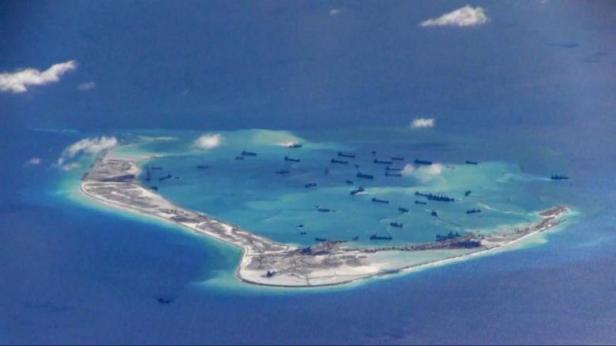
Chinese H-6K bomber with J-11 jets over Sea of Japan 2015
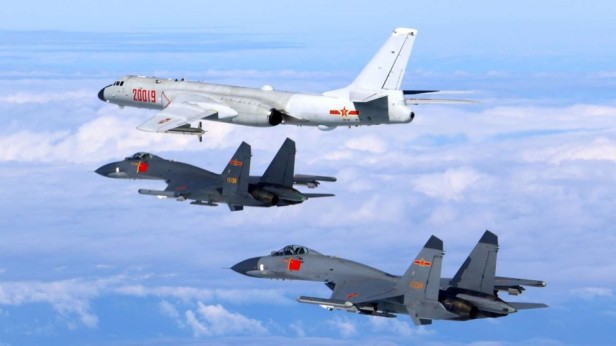
August 2015: Russian – Chinese Naval Drills took place in the Sea of Japan. China’s continued build up and presence in the East China Sea and South China Sea and Sea of Japan threatens Japan’s economy and security. In 2016, Japan’s defense minister would request a record budget of more than $50 billion for 2017.
August 18, 2015: www.MiddleEastEye.net reported that air strikes ‘hitting crowded civilian markets killing almost 100’ brought the death told “since the beginning of violence in 2011, to at least 240,000 killed as the conflict fragments into numerous warring factions… At least four million Syrians have been forced to flee the country and millions of others are internally displaced.”
January 2016: After 37 years, the United States with other European nations LIFTED oil and financial SANCTIONS on IRAN and released roughly $100 billion of its assets after international inspectors concluded that the country had followed through on ‘promises’ to dismantle ‘large sections’ of its nuclear program. President Obama’s Secretary of State, John Kerry, in (foolish) agreement to mend US-Iran relations, while at the International Atomic Energy Agency in January, stated, “Iran has undertaken significant steps that many people …doubted would ever come to pass.”
Early 2016: it was reported that Iran had shipped 98% of its uranium fuel to Russia, and dismantled more than 12,000 centrifuges and poured cement into a core reactor designed to produce plutonium.
February 5, 2016: An article from Russia Beyond the Headlines reported “During his visit to Iran in January, Chinese President Xi Jinping, in addition to signing 17 trade agreements worth more than $600 billion with President Hassan Rouhani, said, “China supports Iran’s application for full membership in the SCO.”
| April 19, 2016: Reuters News reported that Sergei Chemezov, head of Russian conglomerate Rostec said, ‘Russia will complete its deliveries of S-300 air defense systems to Iran by the end of the year.’ According to Rostec’s website: “ROSTEC is a Russian industrial company consisting of 700 organizations… and 14 holding companies… nine of which specialize in the manufacturing of products for the military and industrial sectors… Company products are delivered to markets in more than 70 countries.” Manufacture: ‘high-tech …military equipment.’ |
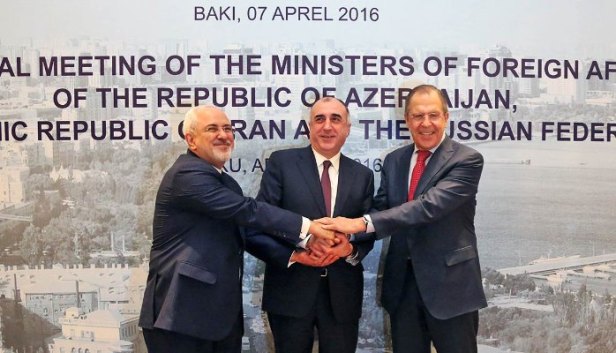
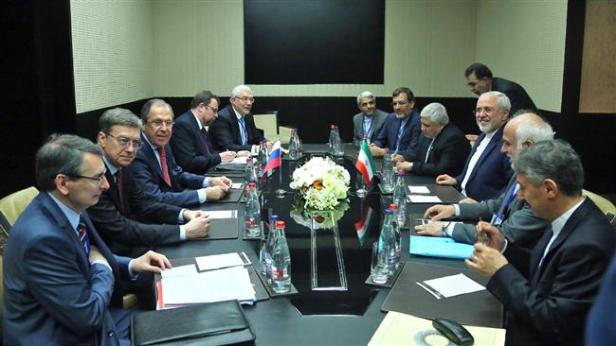 SCO leaders in Azerbaijan voicing support for Iran membership
SCO leaders in Azerbaijan voicing support for Iran membership
April 7, 2016: Russian, Azerbaijani and Iranian foreign ministers met in Baku and agreed to begin preparations for a trilateral summit. They stated, ‘we discussed the North-South transport corridor project’ of the SCO. Iranian Foreign Minister Mohammad Zarif welcomed that Russian Foreign Minister Sergei Lavrov voiced Moscow’s support for Iran’s permanent membership in the Shanghai Cooperation Organization. Lavrov said President Vladimir Putin ordered the lifting of banking sanctions against Iran. They also spoke of continued Tehran-Moscow cooperation in the defense sector and addressed Syrian and Arab (Muslim) issues.
| April 17, 2016: Reuter’s Dubai office reported: “Iran showed off parts of its new Russian S-300 missile defense system during National Army Day on Sunday, where President Hassan Rouhani said the country’s armed forces were no threat to neighboring countries.’ The Iranian President stated, ‘The power of our armed forces is not aimed at any of our neighbors… Its purpose is to defend Islamic Iran and act as an active deterrent.’ Earlier in 2010, Russia canceled a contract to deliver S-300s to Iran due to pressure from Western Nations. President Vladimir Putin lifted the ban in April 2015, after an interim agreement was being worked out with the Obama administration and other world leaders.” |
May 9, 2016: Iran launched a Russian missile from the Alborz Mountains. An Al-Ouds Force Senior Adviser stated, ‘we test-fired a missile with a range of 2,000 kilometers and a margin of error of eight meters.’
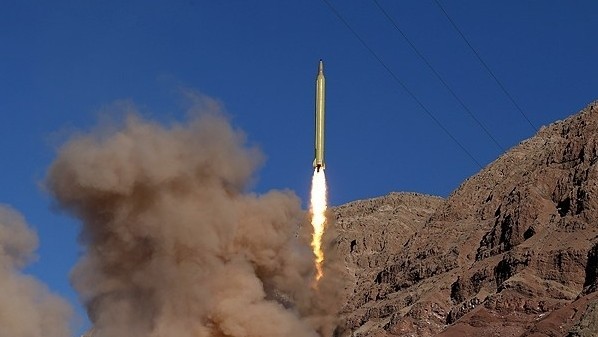
May 22, 2016: www.TheTimesofIsrael.com reported: “Ahmad Karimpour, a senior Iranian military commander boasted that the Islamic Republic could ‘raze the Zionist regime (Israel) in less than 8 minutes.’ ‘Emblazoned on (2 of the) tested ballistic missiles were the words ‘Israel must be wiped off the earth.’
Nevertheless, sanctions have been lifted and Obama gave Iran tens of BILLIONS of $$$ after they continued to break or push the UN decision: ‘Iran is called upon not to undertake any activity related to ballistic missiles designed to be capable of delivering nuclear weapons.’
May 10, 2016: 55 years (1961) since the Russian’s dropped the 50 megaton ‘Tsar Bomba,’ sources such as London’s Mirror.co.uk are reporting, “Russia is gearing up to test their unstoppable ‘Satan 2’ stealth nuke capable of wiping out an ENTIRE NATION’ or ‘area the size of Texas or France… Its official name is the RS-28 Sarmat and it will replace aging Soviet R-36M missiles, which NATO military experts nicknamed ‘Satan’.” Aussie news source (News.com.au) said on May 11, “Russian media boasts of its new Satan II ICBM missiles’ devastating power. Moscow is set to unleash the ‘Son of Satan’ – the world’s biggest nuclear missle… it will be deployed to Siberia where it will undergo testing and refinement. It is due to become FULLY OPERATIONAL in 2018.”
| May 27, 2016: Reuters News reported, “Russian President Vladimir Putin on Friday warned Romania and Poland they could find themselves in the sights of Russian rockets because they are hosting elements of a U. S. missile shield that Moscow considers a threat to its security. Earlier this month the U. S. military – which says the Shield is needed to protect from Iran, not threaten Russia – switched on the Romanian part of the shield. Work is going ahead on another part of the shield, in Poland. ‘If yesterday in those areas of Romania people simply did not know what it means to be in the cross-hairs, then today we will be forced to carry out certain measures to ensure our security,’ Putin told a join news conference in Athens… ‘It will be the same case with Poland,’ he said.” |
June 23-24, 2016: 16th SCO Summit: SCO celebrated the 15 year mark. According to Russia Direct News, The SCO Summit 2016 will go down in history in part because it will be the last of the traditional format. Leaders announced that in 2017 India and Pakistan will be members and officially join the organization. Russia Direct reported that Sanat Kushkumbayev, deputy director of the Kazakhstan Institute for Strategic Studies said in their interview, “the nuclear powers India and Pakistan will change the balance of power with the SCO, where there already are two other NUCLEAR POWERS – Russia and China. Central Asian countries, which had declared their region a nuclear-free zone, will have a difficult time balancing inside such a composition. It is clear that the expansion of the SCO will now move regional problems into the background.” Iran remained in observer status as tensions are high with Western nations. Yet, Chinese president Xi Jinping told reporters, “We are prepared, in accordance with all legal documents, together with others to carefully consider the applications of Iran and Afghanistan.”
Putin called for SCO countries that are not members of the Eurasian Economic Union (EAEU) to join in the Russian-Chinese projects in the Silk Road Economic Belt, saying ‘connecting all SCO member states and the CIS countries in this integration process will pave the way for developing (the formation) a large (broad) Eurasian Partnership.’ Note: It will also may it possible to role more tanks closer to Israel in the future.
Below: from SCO 2016 Summit
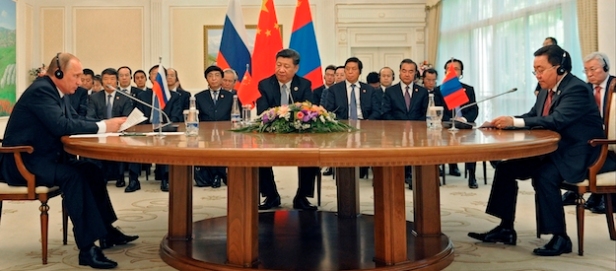
Sources reported that Syria, Egypt and Israel were all interest in joining the SCO.
Andrey Baklitskiy, PIR Center (think tank) Program Director of ‘Russia and Nuclear Nonproliferation,’ stated about the meeting that Iranian membership in the SCO would increase efficiency of the fight against the ‘three evils.’
August 3, 2016: Obama administration ‘secretly’ organized an airlift of $400 million in cash sent to Iran. Americas soon afterwards discover another failed administration negotiation with Iran, paying $100 million per hostage. According to Secretary of State John Kerry, the U.S. agreed to pay another $1.3 billion in interest dating back to the Islamic revolution. Yet, it is well documented that Islamic Terrorist organizations and militants groups kidnap for ransom and then use the money for more weapons and repeat the process it able. More so other nations have paid much less.
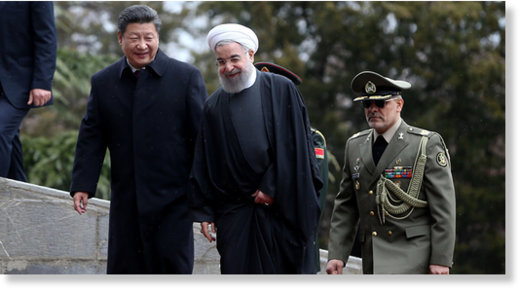
Bonding the Golden Triangle: China, Russia and Iran
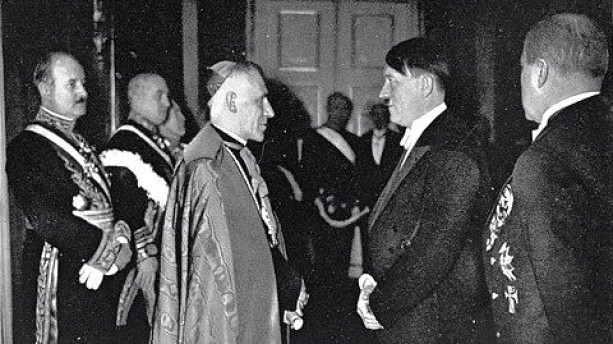
Reminds me of WWII: Catholic Pope, Hitler, Italy relationship
September 2016: Inside sources say that the Obama administration may have sent additional cash and gold totally from 2014 to 2016 as much as $33 billion (this = a semester of college tuition for ALL public college students in the US) according to testimony provided before Congress from an expert at The Washington Free Beacon. Obama authorized $700 million a month to about $12 billion from frozen U.S. sanction funds; as well as an unknown amount of gold.
September 24 to October 10, 2016: Russia and Pakistan conducted ‘Friendship 2016’ military drills. The joint military exercise also included Vietnamese, Mongolian and Indian military. Now Vietnam may be next on the list of dialogue partners at the SCO.
October 2016: The Philippines ended U.S. cooperation and is also likely to seek full membership in the Shanghai Cooperation Organization. President Rodrigo Duterte stated to America, ‘your stay in my country was for your own benefit; it’s time to say goodbye… No more American interference. No more American exercises.’ After 65 years, relations between the US and the Philippines reached a significant low when Barrack Obama criticized them in the method of dealing with their illegal drug criminals – namely for killings of drug dealers by police in alleged summary executions – about 300 in July 2016. The Philippines will also likely seek to join the most powerful Asian (anti-American) coalition.
| October 2016: UK’s Daily Mail News reported that Russia warned the United States and called to officials to “bring relatives home to the Motherland” amid heightened tensions over the prospect of global war. They reported that US-Russia relations were at the ‘lowest point since the Cold war.’ Retired Russian Lt. Gen. Evgeny Buzhinsky told the BBC, “Of course there is a reaction. As far as Russia sees it, as Putin sees it, it is full-scale confrontation on all fronts. If you want a confrontation, you’ll get one. ‘But it won’t be a confrontation that doesn’t harm the interests of the United States. You want a confrontation, you’ll get one everywhere.” |
November 2016: China completed the world’s fastest supercomputer in June (without U.S. chips). It has over 10 million compute cores and is called the Sunway TaihuLight. It exceeds 100 petaflops or 100 quadrillion sustained floating-point operations per second. This November it was said to reach about 125 petaflops of data. The number three is managed by DOE-UT in Tennessee at 17.5 PFLOPS. The number two is also Chinese and about 34 PFLOPS. The number 4 fastest is by IBM in California at about 17 PFLOPS (1.57 million Processing Cores; 1.57 Terabytes of RAM). A typical Apple iPad Pro can do 1.5 GigaFlops; a good desktop does about 100 GFlops.
| Dec. 21, 2016: Congressional Research Service article, ‘Iran’s Foreign and Defense Policies:’ “Along with India and Pakistan, Iran has been given observer status in a Central Asian security grouping called the Shanghai Cooperation Organization (SCO—Russia, China, Kazakhstan, Kyrgyzstan, Uzbekistan, and Tajikistan). In April 2008, Iran applied for full membership in the organization. Apparently in an effort to cooperate with international efforts to pressure Iran, in June 2010, the SCO barred admission to Iran on the grounds that it is under U.N. Security Council sanctions.107 However, some officials from SCO member countries have stated that the the JCPOA removes that formal obstacles to Iran’s obtaining full membership… Shortly after Implementation Day of the JCPOA, China’s President Xi Jinping included Tehran on a visit to the Middle East region. His trip to Iran generally focused on China’s vision of an energy and transportation corridor extending throughout Eurasia (“One Belt, One Road”), and including Iran, and the two countries agreed to expand trade to $600 billion over the coming decade. China’s compliance with U.S. sanctions was pivotal to U.S. efforts to reduce Iran’s revenue from oil sales…” |
January 2017: Former Soviet (Russian) president Mikhail Gorbachev told TIME magazine that “it all looks as if the world is preparing for war… no problem is more urgent today than the militarization of politics and the new arms race. Stopping and reversing this ruinous race must be our top priority…” Gorbachev added, “The current situation is too dangerous.”
Turkey is seeking to join Russia, China, Iran, Pakistan and others in the Shanghai Cooperation Organization (SCO). The U.S. remains barred from group.
Jan. 2017 SCO agreement was completed for International Road Transportation Facilitation between SCO countries. This will also open up more transportation between the EU and SCO countries. The SCO has a Interbank Consortium able to put trillions into a military campaign.
June 7-8, 2017: At the 17th SCO Summit, in Kazakhstan, India and Pakistan were granted full membership into the Shanghai Cooperation Organization.
As of November 2017:
- the SCO comprises eight member states, namely the Republic of India, the Republic of Kazakhstan, the People’s Republic of China, the Kyrgyz Republic, the Islamic Republic of Pakistan, the Russian Federation, the Republic of Tajikistan, and the Republic of Uzbekistan;
- the SCO counts four observer states, namely the Islamic Republic of Afghanistan, the Republic of Belarus, the Islamic Republic of Iran and the Republic of Mongolia;
- the SCO has six dialogue partners, namely the Republic of Azerbaijan, the Republic of Armenia, the Kingdom of Cambodia, the Federal Democratic Republic of Nepal, the Republic of Turkey, and the Democratic Socialist Republic of Sri Lanka.
